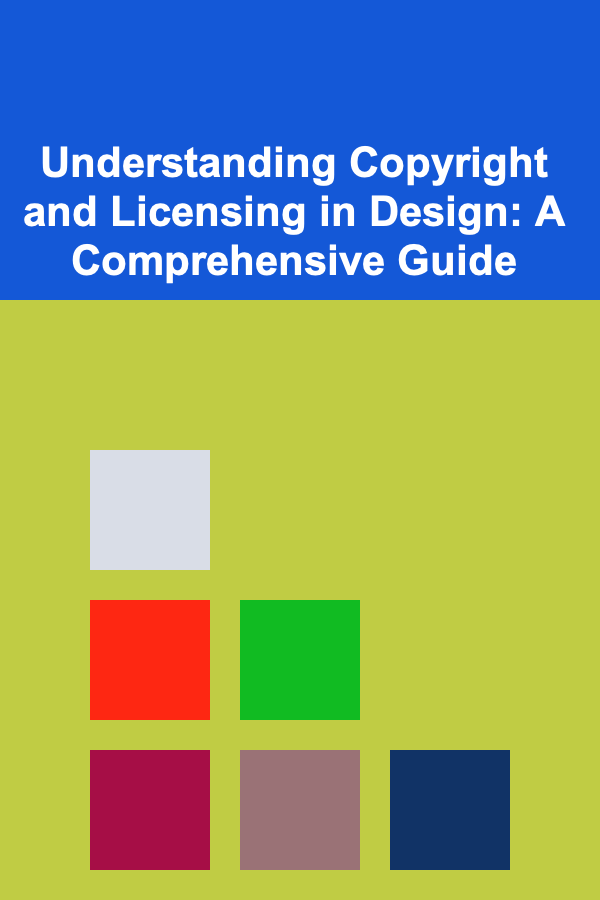
Understanding Copyright and Licensing in Design: A Comprehensive Guide
ebook include PDF & Audio bundle (Micro Guide)
$12.99$11.99
Limited Time Offer! Order within the next:

In the intricate world of design, where creativity reigns supreme, understanding copyright and licensing is not merely an advantage, but a necessity. Whether you're a graphic designer, web developer, architect, fashion designer, or any other creative professional, grasping the legal framework that governs your work is crucial for protecting your intellectual property and ensuring that you operate ethically and legally. This comprehensive guide delves into the depths of copyright and licensing, providing you with the knowledge and tools to navigate this complex landscape with confidence.
What is Copyright?
At its core, copyright is a legal right granted to the creator of original works of authorship, including literary, dramatic, musical, and certain other intellectual works. This right, protected by law, grants creators exclusive control over how their work is used and distributed. Copyright protection arises automatically the moment the work is fixed in a tangible medium -- meaning it's written down, recorded, saved digitally, or otherwise expressed in a way that can be perceived, reproduced, or communicated.
Key Aspects of Copyright:
- Originality: Copyright protects only original works. This doesn't mean the work needs to be entirely novel, but it must possess a minimal degree of creativity and not be copied from another source.
- Tangible Medium: The work must be fixed in a tangible medium of expression. A fleeting thought or idea, however brilliant, isn't copyrightable until it's written down, recorded, or otherwise expressed in a durable form.
- Automatic Protection: In most countries, copyright protection is automatic upon creation. There's no need to register your work for basic copyright protection, although registration offers significant advantages, especially in the event of infringement.
- Duration: Copyright protection doesn't last forever. The duration varies depending on the country and the type of work, but generally, it extends for the life of the author plus a certain number of years (e.g., 70 years after the author's death). For corporate works (works made for hire), the term is typically shorter, often 95 years from publication or 120 years from creation, whichever expires first.
- Exclusive Rights: Copyright grants the owner a bundle of exclusive rights, including the right to:
- Reproduce the work (make copies)
- Distribute copies of the work to the public
- Prepare derivative works based on the copyrighted work
- Display the work publicly
- Perform the work publicly (for certain types of works, like music and dramatic works)
It's important to note that copyright protects the expression of an idea, not the idea itself. For example, the idea of a website that sells shoes isn't copyrightable, but the specific design, layout, and code of a particular website selling shoes is likely to be copyrightable.
What is Licensing?
While copyright grants creators exclusive control over their work, licensing provides a mechanism for granting permission to others to use that work in specific ways. A license is essentially a contract that outlines the terms and conditions under which someone can use a copyrighted work. Licensing allows copyright owners to monetize their creations and control how they are used, while simultaneously allowing others to legally utilize these creations for their own purposes.
Types of Licenses:
- Exclusive License: An exclusive license grants a single licensee the exclusive right to use the copyrighted work in a specific way. The copyright owner cannot grant the same right to anyone else, and may even be restricted from using the work in that way themselves.
- Non-Exclusive License: A non-exclusive license allows the copyright owner to grant the same rights to multiple licensees. This is the most common type of license.
- Commercial License: A commercial license permits the licensee to use the copyrighted work for commercial purposes, such as selling products or services, advertising, or generating revenue. These licenses typically come with a fee.
- Non-Commercial License: A non-commercial license restricts the licensee to using the copyrighted work for non-commercial purposes, such as personal use, educational purposes, or charitable activities. These licenses are often free.
- Royalty-Free License: A royalty-free license allows the licensee to use the copyrighted work without paying ongoing royalties each time the work is used. A one-time fee is typically paid for the license. This doesn't mean the license is free; it simply means you don't have to pay royalties per use.
- Rights-Managed License: A rights-managed license is more restrictive and tailored to specific uses. The price and terms of the license depend on factors such as the intended use, duration, territory, and audience size.
- Creative Commons Licenses: Creative Commons (CC) licenses are a suite of standardized licenses that allow copyright holders to grant certain rights to the public while retaining others. These licenses are widely used for open-source projects, educational materials, and other creative works.
- CC BY (Attribution): Allows others to distribute, remix, adapt, and build upon the work, even commercially, as long as they credit the original author.
- CC BY-SA (Attribution-ShareAlike): Allows others to distribute, remix, adapt, and build upon the work, even commercially, as long as they credit the original author and license their new creations under identical terms.
- CC BY-ND (Attribution-NoDerivatives): Allows others to distribute the work, even commercially, as long as it is passed along unchanged and in whole, with credit to the original author.
- CC BY-NC (Attribution-NonCommercial): Allows others to distribute, remix, adapt, and build upon the work non-commercially, as long as they credit the original author.
- CC BY-NC-SA (Attribution-NonCommercial-ShareAlike): Allows others to distribute, remix, adapt, and build upon the work non-commercially, as long as they credit the original author and license their new creations under identical terms.
- CC BY-NC-ND (Attribution-NonCommercial-NoDerivatives): The most restrictive CC license. Allows others to download and share the work with others as long as they credit the original author, but they can't change it in any way or use it commercially.
- CC0 (Public Domain Dedication): Releases the work into the public domain, waiving all copyright rights.
Key Elements of a License Agreement:
- Parties Involved: Clearly identifies the copyright owner (licensor) and the party receiving the license (licensee).
- Scope of the License: Defines the specific rights granted to the licensee, including the permitted uses, duration, territory, and medium.
- Restrictions: Outlines any limitations or prohibitions on how the licensee can use the copyrighted work.
- Payment Terms: Specifies the fees or royalties to be paid by the licensee, and the payment schedule.
- Attribution Requirements: States how the licensee must credit the copyright owner.
- Termination Clause: Describes the conditions under which the license can be terminated.
- Governing Law: Specifies the jurisdiction whose laws will govern the interpretation and enforcement of the agreement.
Example: Imagine you're a graphic designer creating a logo for a client. You retain the copyright to the logo design, but you grant your client a license to use the logo for their business, including on their website, business cards, and marketing materials. The license agreement would specify the scope of this permission, any restrictions on its use (e.g., prohibiting them from selling the logo to another company), and the payment terms.
Copyright and Licensing in the Design Process
Understanding copyright and licensing is critical throughout the entire design process, from initial concept to final delivery. Failing to do so can lead to legal trouble, damage your reputation, and cost you significant time and money.
Research and Inspiration:
While inspiration is essential for creativity, it's crucial to differentiate between inspiration and infringement. Looking at other designs for inspiration is fine, but directly copying or closely imitating elements of copyrighted works is not. When using images or other assets found online for inspiration, always check the licensing terms to ensure you're allowed to use them, even in preliminary designs. Avoid using copyrighted material in your mood boards or sketches if you don't have permission.
Using Third-Party Assets:
Many design projects involve using third-party assets, such as stock photos, fonts, icons, or music. It's essential to understand the licensing terms associated with these assets before incorporating them into your designs. Pay attention to the allowed uses, restrictions, and attribution requirements. Avoid using assets without a valid license or using them in a way that violates the license terms.
Example: You find a beautiful photograph online that you want to use in a website design. Before using the photo, check its license. If it's a Creative Commons license, make sure you comply with the attribution requirements. If it's a rights-managed license, ensure you're paying the correct fee and using the image only for the permitted purposes.
Creating Original Works:
When creating original designs, be mindful of the elements you're using and ensure they don't infringe on existing copyrights. Avoid using copyrighted characters, logos, or other protected elements without permission. If you're using elements that are similar to existing works, make sure your design is sufficiently transformative to be considered original.
Transferring Copyright to Clients:
In many cases, designers transfer the copyright of their work to their clients. This is typically done through a written assignment agreement. The agreement should clearly specify which rights are being transferred and any limitations on the transfer. Alternatively, designers may choose to retain the copyright and grant the client a license to use the work. The best approach depends on the specific project and the client's needs.
Example: You design a website for a client. You can either transfer the copyright of the website design to the client, giving them full ownership of the work, or you can retain the copyright and grant them a license to use the website design for their business. The client may prefer owning the copyright, while you may prefer retaining it for portfolio purposes or future projects.
Common Copyright and Licensing Mistakes in Design
Despite the importance of copyright and licensing, many designers make common mistakes that can lead to legal issues. Here are some of the most frequent errors:
- Assuming "Fair Use" Covers Everything: Fair use is a legal doctrine that allows limited use of copyrighted material without permission for purposes such as criticism, commentary, news reporting, teaching, scholarship, or research. However, the application of fair use is highly fact-specific and depends on several factors, including the purpose and character of the use, the nature of the copyrighted work, the amount and substantiality of the portion used, and the effect of the use on the potential market for the copyrighted work. It's generally not a good idea to rely on fair use unless you're confident your use qualifies.
- Ignoring Licensing Terms: Many designers download assets without carefully reading the licensing terms. This can lead to using the asset in a way that violates the license, such as using a non-commercial asset for commercial purposes or failing to provide proper attribution.
- Using Stock Photos Without a License: Using stock photos without a license is a clear copyright infringement. Always purchase a license before using stock photos, and ensure the license covers the intended use.
- Copying Logos or Branding Elements: Directly copying logos or branding elements from other companies is a serious copyright infringement. Always create original designs that are distinct from existing brands.
- Failing to Secure Rights for Fonts: Fonts are often copyrighted software. Using fonts without a valid license is illegal. Always purchase a license for the fonts you use in your designs, and ensure the license covers the intended use (e.g., embedding the font in a website or using it in a logo).
- Assuming "Free" Means "Unlimited Use": Just because something is available for free online doesn't mean it's free to use for any purpose. Always check the licensing terms before using free resources. Many free resources have restrictions on commercial use or require attribution.
- Not Having Written Agreements with Clients: Failing to have a written agreement with your clients regarding copyright ownership and licensing can lead to disputes down the line. Always have a clear agreement that specifies who owns the copyright to the design and how the client is allowed to use it.
- Not Properly Transferring Copyright: If you intend to transfer copyright to your client, make sure you do so through a written assignment agreement. A simple verbal agreement or an invoice stating "full ownership" is not sufficient to legally transfer copyright.
Strategies for Protecting Your Designs
As a designer, protecting your own work is just as important as respecting the copyrights of others. Here are some strategies for safeguarding your intellectual property:
- Copyright Registration: While copyright protection is automatic upon creation, registering your work with the copyright office provides significant advantages, particularly in the event of infringement. Registration creates a public record of your copyright claim and allows you to sue for statutory damages and attorney's fees in infringement lawsuits.
- Watermarking: Watermarking your designs can deter unauthorized use. A watermark is a semi-transparent overlay that identifies you as the copyright owner.
- Terms of Service: If you display your designs online, include clear terms of service that prohibit unauthorized copying or distribution.
- Copyright Notices: Include copyright notices on your designs, especially if they are displayed publicly. A copyright notice typically consists of the copyright symbol (©), the year of creation, and the name of the copyright owner.
- Licensing Agreements: Use clear and comprehensive licensing agreements when granting rights to others. Ensure the agreements specify the permitted uses, restrictions, and payment terms.
- Monitoring Your Work Online: Regularly monitor the internet for unauthorized copies of your designs. There are various tools and services available that can help you track your work online.
- Taking Action Against Infringement: If you discover that your copyright has been infringed, take prompt action to protect your rights. This may involve sending a cease and desist letter, filing a lawsuit, or pursuing other legal remedies.
- Using Creative Commons Licensing (Strategically): Consider using Creative Commons licenses to allow certain uses of your work while retaining control over others. This can be a good way to promote your work and encourage collaboration, but make sure you understand the implications of each license.
- Embedding Metadata: Embed copyright information and licensing terms directly into the metadata of your digital files. This makes it easier for others to identify the copyright owner and understand the terms of use.
Ethical Considerations
Beyond the legal requirements, ethical considerations play a crucial role in copyright and licensing. As a designer, you have a responsibility to respect the intellectual property of others and to act with integrity. This includes:
- Giving Credit Where Credit Is Due: Always properly attribute the work of others when required by a license or by ethical considerations.
- Avoiding Plagiarism: Never present someone else's work as your own.
- Being Transparent with Clients: Clearly communicate with your clients about copyright ownership and licensing issues.
- Respecting the Rights of Creators: Recognize the value of creative work and respect the rights of copyright holders.
- Staying Informed About Copyright Law: Keep up-to-date on the latest developments in copyright law and licensing practices.
Resources for Further Learning
Understanding copyright and licensing is an ongoing process. Here are some resources that can help you stay informed:
- The U.S. Copyright Office: www.copyright.gov
- Creative Commons: creativecommons.org
- World Intellectual Property Organization (WIPO): www.wipo.int
- Copyright Clearance Center: www.copyright.com
- Legal Counsel: Consult with an attorney specializing in intellectual property law for specific legal advice.
Conclusion
Copyright and licensing are fundamental aspects of the design profession. By understanding the legal principles involved and adopting ethical practices, designers can protect their own work, respect the rights of others, and navigate the complex world of intellectual property with confidence. This comprehensive guide provides a solid foundation for understanding these issues, but it's important to stay informed and seek legal advice when needed. Mastering copyright and licensing is not just about avoiding legal trouble; it's about fostering a culture of creativity and innovation that benefits both designers and the public.
By embracing a proactive and informed approach to copyright and licensing, designers can ensure their continued success and contribute to a thriving creative ecosystem.
Disclaimer: This information is for general guidance only and does not constitute legal advice. Consult with an attorney for advice tailored to your specific situation.
Reading More From Our Other Websites
- [Survival Kit 101] Best Survival Kit for Mountain Bikers Tackling High‑Elevation Trails
- [Beachcombing Tip 101] How to Build a Compact Beachcombing Toolkit for Solo Shore Explorers
- [Home Cleaning 101] How to Remove Pet Odors Naturally From Your Whole House
- [Personal Care Tips 101] How to Use Body Butter for a Deep Moisturizing Nighttime Routine
- [Personal Investment 101] How to Maximize Returns with High-Yield Savings Accounts
- [Home Cleaning 101] How to Declutter and Clean Your Garage for Maximum Storage
- [Small Business 101] How to Optimize Your Small Manufacturing Workflow Using Lean Six Sigma Principles
- [Home Maintenance 101] How to Inspect Your Roof After a Storm and Prevent Future Damage
- [Organization Tip 101] Victorian Home Paint Trends: Top Colors for 2025
- [Home Budget 101] How to Implement Effective Money Management Tips to Build a Robust Emergency Fund

How to Soundproof Your Home to Create a Meditation Space
Read More
How to Stage a Home with Minimal Renovation
Read More
How to Understand the Stock Market for Beginners
Read More
Calculating Your Home's Energy Needs for Renewables: A Comprehensive Guide
Read More
10 Tips for Stand-Up Paddleboarding with Kids
Read More
How to Edit Cinematic Travel Videos on Your Phone
Read MoreOther Products

How to Soundproof Your Home to Create a Meditation Space
Read More
How to Stage a Home with Minimal Renovation
Read More
How to Understand the Stock Market for Beginners
Read More
Calculating Your Home's Energy Needs for Renewables: A Comprehensive Guide
Read More
10 Tips for Stand-Up Paddleboarding with Kids
Read More